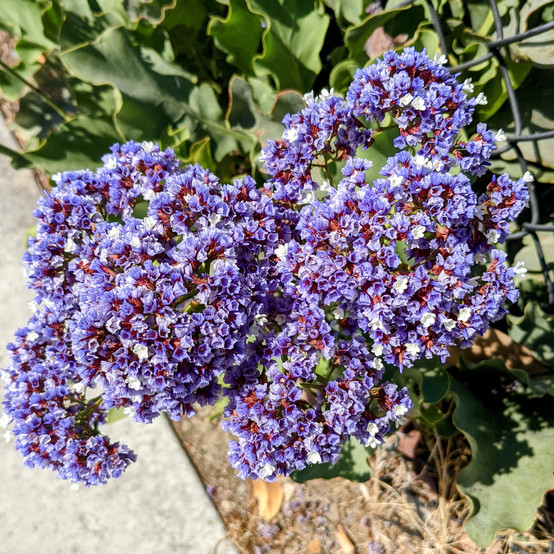
Valley Water, Santa Clara County's water authority, has been a leading influence in helping community members find practical and creative ways to save water. Their headquarters includes a well-maintained and informative drought tolerant demonstration garden. For homeowners that can finally let go of their lawns, Valley Water is currently offering a rebate program to incentivize transitions from lush carpets to conservation gardens with added benefits to the environment (think pollinators and birds, as examples). Valley Water also manages the county's ground water, and this brings me to our plant du jour, Limonium perezii, a.k.a. sea lavender or statice.
Near the corner of Hacienda Avenue and Winchester Boulevard in Campbell, CA, a pair of collection ponds flank the roadway. Not remarkable from a landscape point of view, but seeing them fill with water gives me slight relief, the same feeling I have after a seasonal rain freshens the air. So far this season, the ponds are dry, waiting for the first opportunity to fill. Framing the top embankments of both ponds are a scattering of sea lavenders. I cannot imagine the plants receiving much water amidst the dusty dry field grass; adjacent drought tolerant trees are wilting in this late summer/early autumn heat. Yet, the sea lavenders are thriving, lush with green and just wrapping up their long summer bloom period. Some of the photos below are from this location, including the feature photo above.
While Sunset lists L. perezii as a moderate water user, the University of California, Davis, Center for Urban Horticulture, in partnership with the California Department of Water Resources, categorized this species for needing low water consumption within the Bay Area, as listed in the Water Use Classification of Landscape Species (WUCOLS). Landscape architects use this reference to determine the hydrozone for each plant, so I am inclined to rely on WUCOLS for up to date information...and my observations.
L. perezii is an adaptable species, from moderate to low water use with varying landscape conditions, or as Sunset states, a "first-rate beach plant" (p. 415). Hence the common name. It offers designers a unique opportunity to specify a coarse-textured plant at home in modern, Mediterranean, sub-tropical, seaside, or rock gardens without a lot of fuss. I just planted one in an orange-glazed container in my own garden, apparently wanting to shock my visual senses of color but also a need to observe its behavior first-hand...sort of an upgrade from the days I would specify it on plans but never really grasping its behavior. I will share updates on its performance.
Bay Area landscape architect, Jeff Wortham, provides a thorough overview of this species, including recommendations for compatible plants.
facts
Botanical Name: Limonium perezii
Limonium: Greek, leimon, for meadow
Perezii: Honoree, possibly for Dr. George V. Perez, provider of seeds to the Royal Botanic Gardens at Kew, London
Common Name: Statice; sea lavender; seafoam statice; marsh rosemary
Family Name: Plumbaginaceae
Origin: Canary Islands
design considerations
Positioning: Foreground, drifts, slopes
Garden Themes: Mediterranean/dry, desert, rock, coastal, courtyard/patio, cottage, cutting, pollinator
Uses: Border, accent, mass, container, floriculture
identifying characteristics
Type: Herbaceous perennial (evergreen)
Form: Clump
Texture: Coarse
Size: 12"-18" tall by 3' wide
Outstanding Feature(s): Flower
Stem: N/A
Leaf:
Type: Simple
Arrangement: Basal
Shape: Ovate
Margin: Entire with minute pubescence
Color: Dull medium green
Surface: Scabrous above, tomentose underneath
Flower: Spring to Summer (may dry and persist into early Autumn). Showy, branched clusters on rigid stalks composed of purple calyxes and white corollas. Calyxes dry becoming an interest for flower arrangements.
Fruit: Autumn to Winter. Inconspicuous
cultural requirements, tolerances & problems
Sunset Zones: 13, 15-17, 20-24
USDA Zones: 9-11
Light: Sun
WUCOLS SF Bay Area Hydro Zone: Low
Soil:
Texture: Sand, loam, rocky
Moisture Retention: Well-drained but performs better with moisture
pH: Neutral to slightly alkaline
Tolerances: Heat, dear
Problems: May reseed in Southern California coastal conditions; snails
Branch Strength: N/A
Insects: Not recorded at time of posting
Disease: Rots, anthracnose, botrytis
citations & attributions
Bayton, R. (2019). The Royal Horticultural Society's the Gardener's Botanical: An Encyclopedia of Latin Plant Names. London: Mitchell Beazley.
Inland Valley Garden Planner. "Sea Lavender: Limonium perezii." Chino Basin Water Conservation District, Montclair. Accessed on September 22, 2021, from https://inlandvalleygardenplanner.org/plants/limonium-perezii/.
Martin, C.A. (n.d). "Virtual Library of Phoenix Landscape Plants." Arizona State University, Phoenix. Accessed on September 22, 2021, from http://www.public.asu.edu/~camartin/plants/Plant%20html%20files/limoniumperezii.html.
Norris Brenzel, K. (Ed.). (2012). The New Sunset Western Garden Book. New York: Time Home Entertainment, Inc.
Pendergrass K., Vaughan, M., Williams, J. (2008, March). Technical Notes: Plants for Pollinators in Oregon. U.S. Department of Agriculture, Natural Resources Conservation Service, Portland. Accessed on September 22, 2021 from https://www.nrcs.usda.gov/Internet/FSE_DOCUMENTS/nrcs142p2_041919.pdf.
Penn State Extension. "Statice Diseases." Pennsylvania State University, University Park. Accessed on September 22, 2021, from https://extension.psu.edu/statice-diseases.
Products. "Limonium perezii." San Marcos Growers, Santa Barbara. Accessed on September 22, 2021, from https://www.smgrowers.com/products/plants/plantdisplay.asp?plant_id=997.
Water Use Classification of Landscape Species. "WUCOLS IV Plant List." University of California, Division of Agriculture and Natural Resources, Davis. Accessed on September 7, 2021.
Photos:
All other photos by TELCS.















Commenti